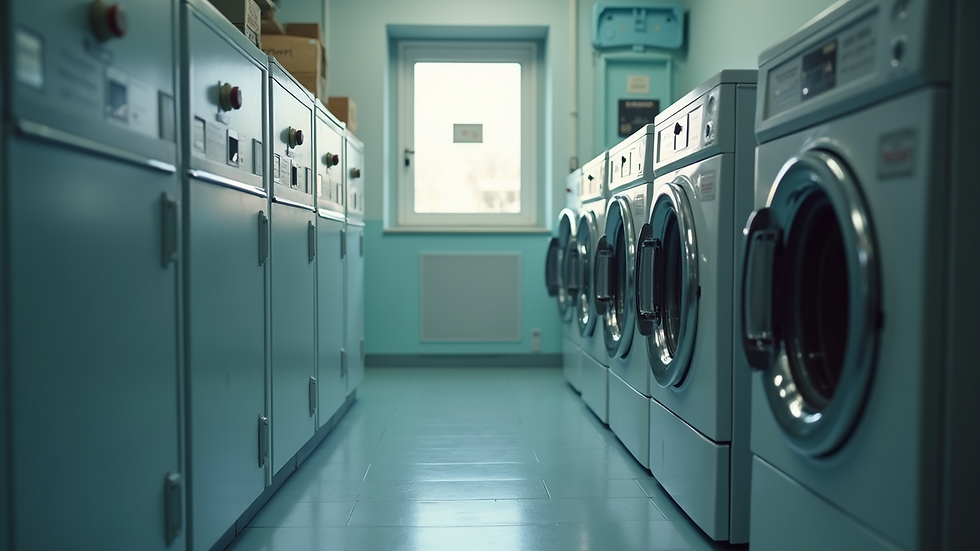Effective Solutions for Troubleshooting Washer Drain Issues
- Murodilla Musaboyev
- Aug 13
- 4 min read
Dealing with a washer that isn't draining can be quite frustrating. Every time you load the machine, you hope for a smooth laundry day, but a malfunctioning washer can throw off your rhythm. The good news? Many common drainage issues can be fixed with some basic troubleshooting. This guide will help you identify and resolve the problem, getting your washer back to normal in no time.
Understanding the Problem
Before jumping into solutions, it’s crucial to grasp why your washer might not be draining. Several factors could contribute to this issue, such as clogs, mechanical failures, or electrical problems. For instance, research indicates that nearly 60% of washer drainage issues are due to clogs either in the drain hose or pump. Identifying the root cause will help you choose the best solution.
Check the Drain Hose
The first step in troubleshooting is inspecting the drain hose.
Positioning: Ensure the hose is straight and not kinked. Ideally, it should be positioned between 30 to 96 inches above the floor, which allows for optimal water flow.
Clogs: Detach the hose and check for blockages. Use a long object like a straightened coat hanger to gently dislodge any debris. In 2022, a study found that approximately 30% of homeowners faced washer issues due to blockages in the drain hose.

Inspect the Drain Pump
If the hose looks fine, the next area to check is the drain pump.
Accessing the Pump: For most washers, you may need to remove a front or back panel to access the pump. Always remember to unplug the washer first to ensure safety.
Debris Removal: Inspect the pump for small foreign objects such as coins or buttons that can obstruct its function. A survey of appliance repair professionals revealed that one in four service calls related to washer issues stem from debris in the pump.
Testing the Pump: If the pump appears clear but isn't working, you might need a multimeter to test its electrical continuity. If it’s found to be faulty, it will need to be replaced.
Examine the Lid Switch
Lid switches are essential safety features in many washers. They prevent the machine from draining when the lid is open.
Testing the Switch: Open and closely shut the lid to see if the washer responds. If it doesn’t drain, the lid switch may need to be replaced.
Replacement: Consult your washer’s manual for specific steps on replacing a faulty lid switch. These switches generally cost around $15 to $30 and can be easily installed.
Look for Blockages in the Drain
Sometimes, the blockage is in the drain itself.
Check the Drain: If your washer drains into a standpipe, ensure it is clear of obstructions. Using a plumber's snake can effectively clear any clogs. Statistics show that up to 20% of drain issues stem from house piping problems.
Sump Pump Issues: If your washer connects to a sump pump, verify that it is functioning correctly. A malfunctioning sump pump can halt drainage and lead to water backup.
Review the Water Level Control
The water level control ensures the washer fills with the right amount of water. If it’s not working properly, drainage might be affected.
Testing the Control: Examine the water level control for any visible signs of wear or damage. If it appears faulty, it likely needs replacement.
Check for Electrical Issues
Electrical problems can complicate drainage efforts.
Inspect Wiring: Look for any frayed or damaged wires linked to the drain pump or lid switch. Most electrical faults can be traced back to visible wear.
Circuit Breaker: Make sure the circuit breaker hasn’t tripped. If it has, resetting it may resolve your drainage issue.
Regular Maintenance Tips
To avoid future drainage problems, consider adopting these maintenance practices:
Clean the Filter Regularly: Most washers have a filter that can get clogged over time. Cleaning it to maintain proper drainage will increase your washer's lifespan.
Run Hot Water Cycles Occasionally: This practice helps dissolve soap scum and debris that can obstruct drains, leading to smoother operation.
Avoid Overloading the Washer: Excess load can lead to drainage issues. Following the manufacturer's guidelines, many recommend not exceeding 15-20 pounds per load.
When to Call a Professional
If you have tried all the above solutions and your washer still isn’t draining, it may be time to call in a professional.
Complex Repairs: Complications such as issues with the control board or internal components often require specialized expertise.
Warranty Considerations: If your washer is still under warranty, contacting the manufacturer or retailer is advisable to avoid voiding coverage.
Final Thoughts
Troubleshooting a washer that isn’t draining may seem complex, but many issues can be resolved with a straightforward approach. By examining the drain hose, checking the pump, and ensuring every component is working, you can often restore your washer to normal. Regular maintenance also goes a long way in preventing future issues, keeping your laundry routine efficient. If all else fails, seek professional assistance. Happy washing!






Comments